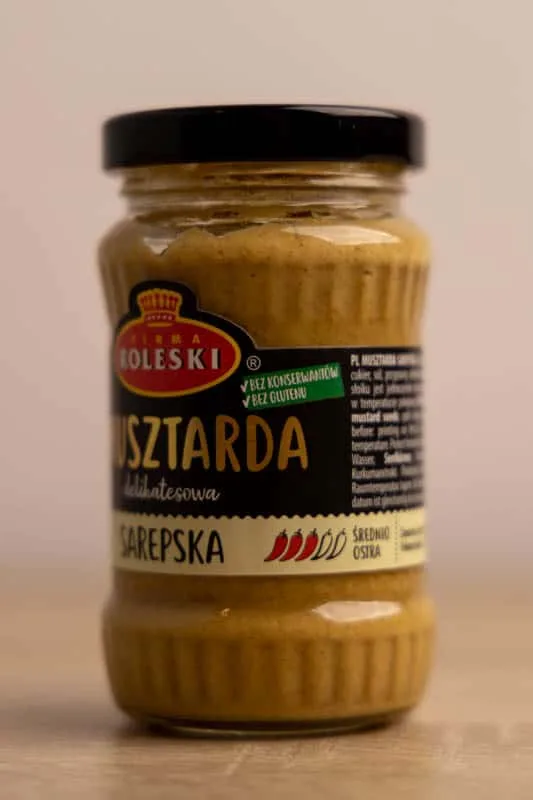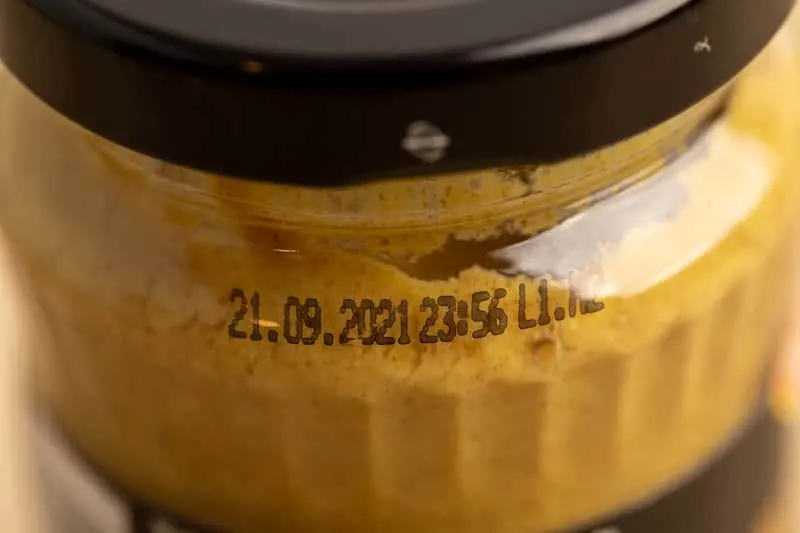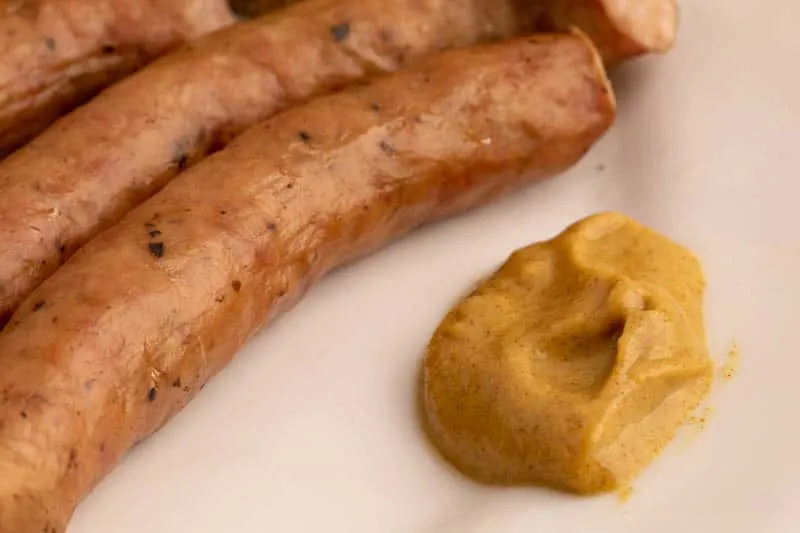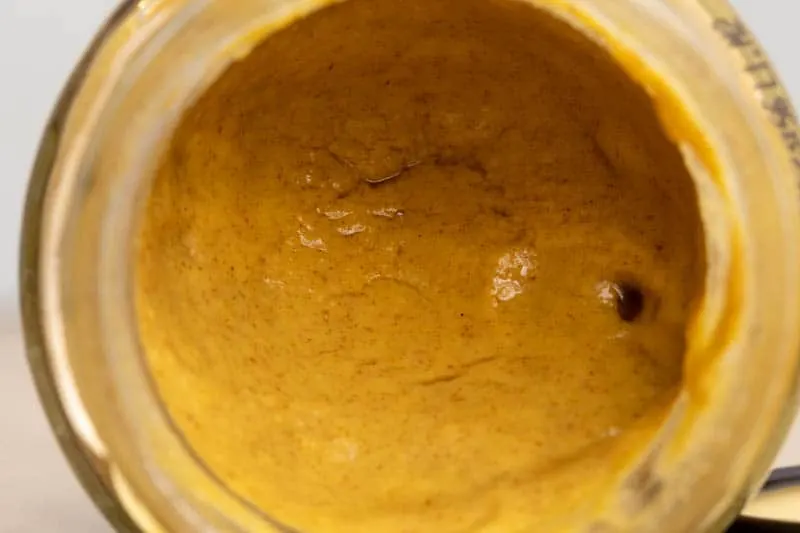In a Nutshell
- Shelf life: Unopened mustard can last up to 3 years; opened mustard remains good for up to 1 year.
- Spoilage signs: Discoloration, off smell, or mold growth may indicate spoilage.
- Storage methods: Store mustard in a cool, dark place before opening, and refrigerate after opening.
Mustard is a staple condiment in many kitchens, but have you ever wondered how long it lasts or the best way to store it?
In this article, we’ll delve into the details of mustard’s shelf life, signs of spoilage, and proper storage methods to help you keep your favorite condiment fresh and flavorful. You’ll be surprised to discover just how long mustard can last and how to spot when it’s time to toss it out.
Join us as we explore this versatile condiment, and you’ll never have to second-guess your mustard choices again.
For starters, let’s talk about the shelf life of mustard.

Table of Contents
- How Long Does Mustard Last?
- How to Tell if Mustard is Bad?
- Common Yet Harmless Changes in Mustard: What Not to Worry About
- Does Mustard Need to Be Refrigerated?
- How to Store Mustard
How Long Does Mustard Last?
Mustard has a shelf life of up to 3 years when unopened and up to 1 year after opening. Its longevity largely depends on storage practices and the specific type of mustard.
Unopened Mustard
Unopened mustard can last a surprisingly long time, up to 3 years, thanks to its vinegar content, which acts as a preservative. The high acidity of vinegar inhibits bacterial growth, similar to what you find in other vinegar-based condiments such as ketchup and barbecue sauce.
Proper storage plays a key role in maintaining mustard’s freshness; keeping it in a cool, dark place will help prolong its shelf life.
Opened Mustard
Once opened, mustard typically remains good for up to 1 year if properly stored. Refrigeration is crucial in this case, as it slows down the degradation process and prevents the growth of harmful microorganisms.
Some sources, like Wikipedia, even claim that mustard lasts indefinitely.
As with other condiments like Tabasco sauce, Worcestershire sauce, and soy sauce, opened mustard may last longer than the recommended time frame if stored correctly, but it’s best to check for signs of spoilage before using it.
(We’ll cover those in a moment.)
In summary, mustard has a relatively long shelf life, with both unopened and opened varieties outlasting many other condiments. By following proper storage practices, you can keep your mustard fresh and ready to take your favorite dishes to the next level.

How to Tell if Mustard is Bad?
To tell if mustard is bad, look for signs such as discoloration, an off smell, or mold growth. These indicators suggest that your mustard may be spoiled, and you shouldn’t eat it.
Let’s cover each one in a bit more detail.
Mold Growth
Mold clearly indicates that your mustard has gone bad and should not be consumed. It may appear as fuzzy spots or patches on the surface of the mustard, or even on the container’s lid. If you spot any mold, throw the entire jar away, as mold can release toxins that contaminate the entire product.
Off Odor
Spoiled mustard may emit an unpleasant or sour smell, which is a strong indicator that it’s no longer safe to eat. Always give your mustard a sniff before using it; if it smells off, trust your nose and discard the product.
Discoloration
Over time, mustard can lose its vibrant color and become dull or darkened. This change in appearance is often the first sign that the condiment has begun to deteriorate. While slight discoloration may not necessarily mean the mustard is unsafe to consume, it could indicate a decline in quality and flavor.
In other words, carefully examining your mustard for discoloration, off smells, and mold growth will help you determine whether it’s still safe to use. When in doubt, err on the side of caution and discard any mustard that shows signs of spoilage.
In case you were wondering, these signs apply to all types of mustards, including dijon, honey mustard, or the classic yellow mustard. And they definitely apply to homemade mustard, too.

Common Yet Harmless Changes in Mustard: What Not to Worry About
There are a few changes in mustard that might seem concerning but are usually harmless. Those are:
Expiration
Expired mustard is usually perfectly fine for at least a couple of months beyond the printed date, assuming that there aren’t any spoilage signs present.
That said, you shouldn’t eat expired mustard that’s more than, say, six months beyond the printed date. Or less if you want to be conservative.
Separation
Don’t be alarmed if you notice some separation in your mustard, as it’s a natural occurrence. The liquid part of the mustard, usually vinegar or water, can separate from the solid ingredients over time. This can also happen in other condiments like Italian dressing (or almost any other salad dressing).
Simply give the mustard a good stir to mix everything back together, and it should be good to go.

Thickening
Mustard can sometimes vary in thickness, even within the same container. This is due to the natural settling of the mustard seeds or other solid ingredients.
Similar to what you might experience with horseradish sauce or Dijon mustard, this change in texture doesn’t necessarily indicate spoilage. A quick stir should even out the consistency, making it ready for use.
And if it’s the bottom of a jar with only a spoonful of dry mustard, you can try adding a bit of wine or vinegar before stirring the old mustard. That should help with fixing the texture.
Crust Formation
Finding a crust around the rim or the lid of your mustard jar might be concerning, but it’s usually just dry mustard. This is a common occurrence in condiments that are stored for extended periods or not properly sealed.
To avoid this, ensure the jar is tightly sealed after each use and wipe away any residue from the rim using a dry (or slightly moist) paper towel. I typically don’t bother with that and am okay with a bit of a crust.
Color Change
You might notice slight color variations in your mustard, but this doesn’t always mean it’s spoiled. Mustard’s hue can change over time or due to exposure to light, but it’s still safe to consume.
Similar color changes can occur in other condiments like browning hot sauce.
As long as the mustard doesn’t show other signs of spoilage, it should be fine to use.

Does Mustard Need to Be Refrigerated?
Unopened mustard does not require refrigeration, but opened mustard should be stored in the refrigerator to maintain freshness and prevent spoilage. It’ll lose quality much sooner if you leave it at room temperature.
Sure, diners can get away with serving mustard in those plastic squeeze bottles and leaving them on the counter, but they go through a couple of them in a week. Going through the same amount would likely take you a couple of months, if not more.
Before opening, mustard can be safely stored at room temperature, similar to other condiments. The vinegar content in mustard acts as a natural preservative, inhibiting the growth of harmful microorganisms.
However, once opened, mustard benefits from being refrigerated. Cold storage slows down the degradation process and helps maintain the condiment’s quality and flavor for longer.
Refrigerating opened mustard is particularly important during warmer months or in humid climates, where the risk of spoilage is higher. Other condiments (I’m looking at you, mayonnaise) also benefit from refrigeration after opening due to their ingredients’ perishable nature.

How to Store Mustard
To maximize the shelf life of unopened mustard, store it in a cool, dark place, such as a pantry or cupboard. Avoid exposing the container to direct sunlight or heat sources like stoves, as these conditions can cause the mustard to spoil more quickly.
Once you’ve opened a jar of mustard, transfer it to the refrigerator to keep it fresh and flavorful. And make sure the container is tightly sealed to prevent air exposure and moisture from entering, which could lead to spoilage.
If the container breaks, transfer the condiment into an airtight container or glass jar, which should work just as well as the original jar or squeeze bottle.
Storing mustard in the refrigerator door is convenient, but placing it on a shelf inside the fridge will help maintain a more consistent temperature.
Finally, always use clean utensils and avoid double dipping. This way, you’ll avoid cross-contamination and your open mustard going bad.
By following these storage guidelines, you’ll ensure that your favorite condiment remains fresh and safe to enjoy with your meals.
